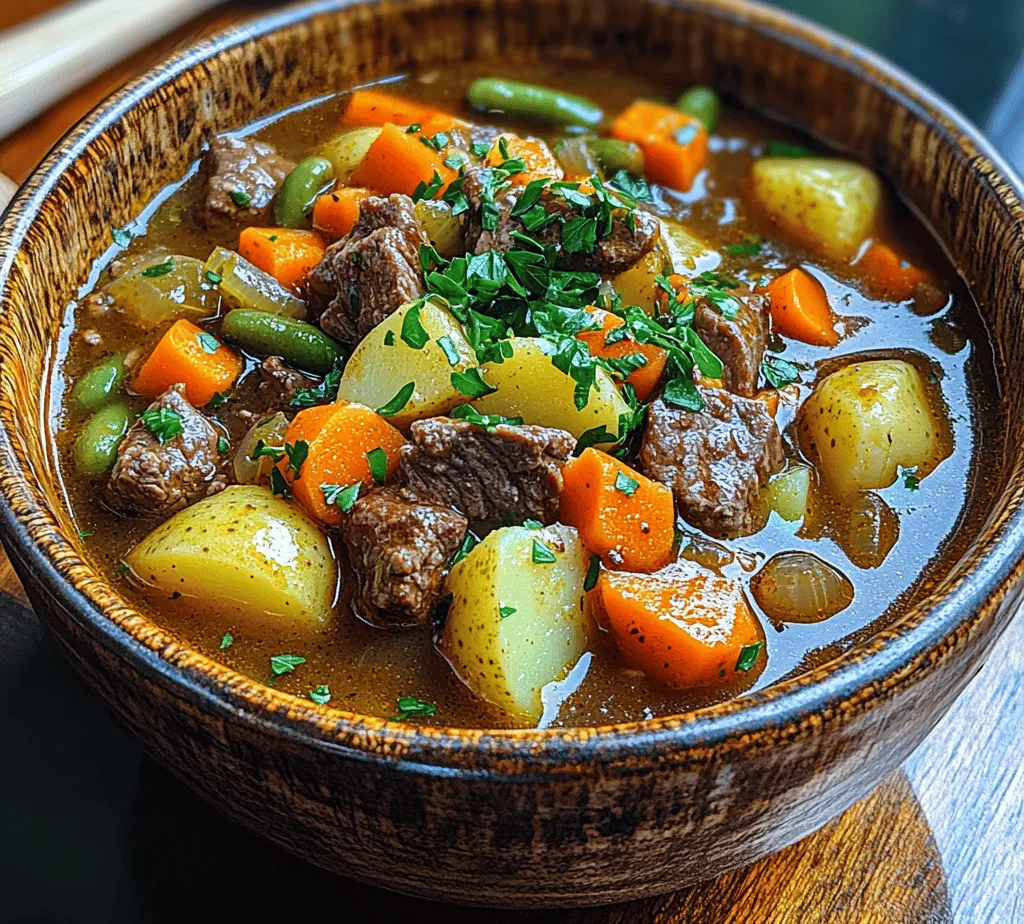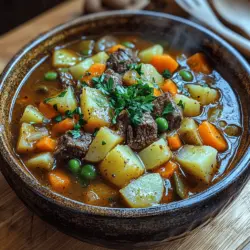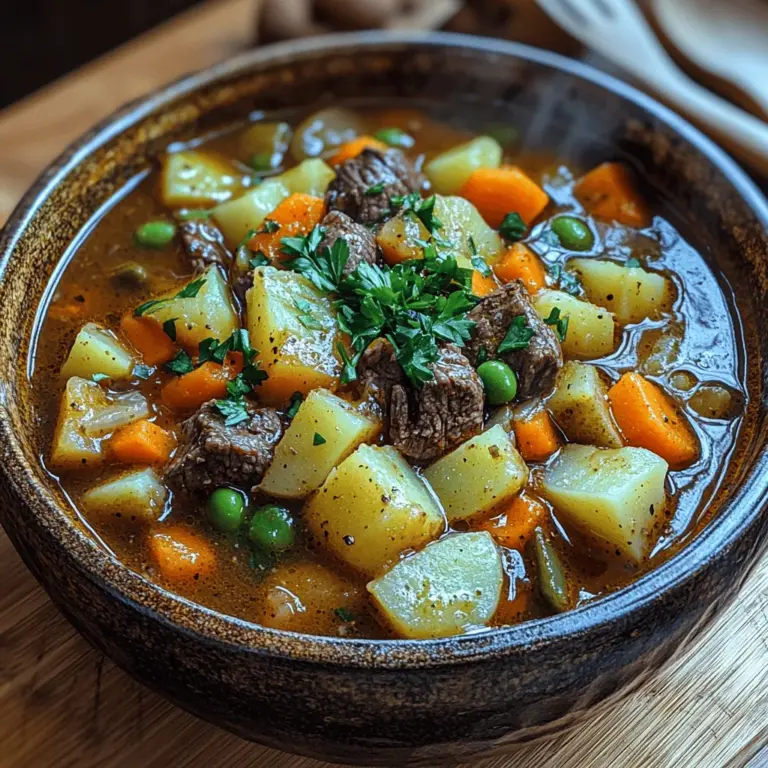Introduction
When the temperature drops and the days grow shorter, there’s nothing quite like a steaming bowl of homemade soup to warm your heart and soul. The nostalgic aroma of simmering ingredients wafting through your kitchen can evoke cherished memories of family gatherings and cozy evenings spent around the dinner table. Soup is more than just a meal; it’s a comforting ritual that brings people together. This is especially true for the Hearty Homestyle Vegetable Beef Soup, a wholesome recipe that embodies the essence of home-cooked goodness.
What sets this soup apart is its robust combination of hearty ingredients, each packed with essential nutrients, making it an ideal choice for everyday meals. The richness of beef stew meat combined with an array of colorful vegetables creates a dish that not only satisfies hunger but also nourishes the body. In this article, we will explore the benefits of each ingredient, delve into the preparation steps, and uncover the cooking process that transforms these components into a delectable soup your whole family will love.
Understanding the Ingredients
To create a truly comforting Hearty Homestyle Vegetable Beef Soup, the quality and type of ingredients used are paramount. Let’s take a closer look at the core ingredients that make this soup a standout dish.
Core Ingredients
1. Beef Stew Meat: The star of our soup, beef stew meat, is typically cut from tougher, less expensive cuts of beef, such as chuck or round. While these cuts may not be the most tender when raw, they are rich in collagen and connective tissue, which break down during the cooking process, resulting in a tender and flavorful meat. Beef is an excellent source of high-quality protein, essential for muscle repair and growth, and it’s also packed with iron, a crucial mineral for transporting oxygen throughout the body.
2. Carrots: These vibrant orange vegetables are not just visually appealing; they are also packed with vitamins and minerals. Carrots are particularly high in beta-carotene, which the body converts into vitamin A, supporting eye health and immune function. Their natural sweetness balances the savory flavors of the beef, adding depth to the overall taste of the soup.
3. Celery: Often overlooked, celery plays a critical role in soups. Its mild, earthy flavor enhances the overall taste profile while contributing valuable nutrients like vitamin K, folate, and potassium. Celery also adds a satisfying crunch to the mix, elevating the texture of the soup.
4. Green Beans: These fresh, crisp vegetables add a pop of color and a delightful crunch to the soup. Green beans are rich in vitamins A, C, and K, as well as fiber, making them a nutritious addition to any meal. They also provide a satisfying contrast to the tender beef and soft root vegetables.
5. Potatoes: A hearty soup wouldn’t be complete without potatoes. They add bulk and creaminess to the dish, making it more filling. Potatoes are an excellent source of carbohydrates, providing energy, and they contain important nutrients like vitamin C, B6, and potassium.
6. Herbs and Spices: The final touch to our soup comes from the combination of herbs and spices. Commonly used ingredients include bay leaves, thyme, and black pepper. Not only do these seasonings enhance the flavor, but many herbs also possess health benefits, such as anti-inflammatory and antioxidant properties, contributing to overall wellness.
Preparation Steps Explained
Creating the Hearty Homestyle Vegetable Beef Soup is a straightforward process, but it’s the attention to detail during preparation that will take your soup from good to great. Here are the essential steps to ensure that every bite is filled with flavor.
Step 1: Browning the Beef
The first crucial step in making the perfect beef soup is browning the beef stew meat. This process is essential for developing a rich, deep flavor that will serve as the foundation of your soup. Start by cutting the beef into evenly sized cubes, ensuring they cook uniformly. Pat the meat dry with paper towels to remove excess moisture—this will help achieve a nice sear.
Heat a tablespoon of oil in a large pot or Dutch oven over medium-high heat. Once the oil is shimmering, add the beef in a single layer, making sure not to overcrowd the pot. Allow the meat to brown on all sides without stirring for a few minutes; this caramelization is what adds depth to the soup. After browning, remove the beef from the pot and set it aside.
Step 2: Sautéing the Vegetables
With the beef removed, it’s time to bring the pot to life by sautéing the vegetables. In the same pot, add another tablespoon of oil if needed, then toss in the chopped onions, carrots, and celery. Sautéing these aromatic vegetables will release their natural flavors, creating a fragrant base for your soup.
Cook the vegetables for about 5-7 minutes, stirring occasionally until they soften and the onions become translucent. This step is vital, as it builds the flavor profile of the soup. For an added layer of flavor, consider adding minced garlic during the last minute of sautéing. Garlic not only enhances taste but is also known for its immune-boosting properties.
Step 3: Combining Ingredients
Once the vegetables are sautéed, it’s time to bring all the ingredients together. Return the browned beef to the pot and mix it with the sautéed vegetables. At this point, you can add the green beans and diced potatoes as well. Stir everything together to ensure the ingredients are well combined.
Next, it’s time to add the liquid that will form the broth. Pour in beef broth or stock, ensuring that the ingredients are fully submerged. The quality of the broth plays a significant role in the overall taste of the soup, so opt for low-sodium or homemade broth if possible.
Step 4: Seasoning
Before moving on to the cooking phase, don’t forget to season your mixture. Add bay leaves, thyme, salt, and pepper to taste. It’s important to note that seasoning early on allows the flavors to meld together as the soup simmers, but you can always adjust the seasoning later.
Cooking Process
The final step in creating your Hearty Homestyle Vegetable Beef Soup is the cooking process. This is where the magic happens, and understanding how to simmer and slow cook will ensure a delicious outcome.
Simmering
Bring the soup to a gentle boil over medium-high heat, then reduce the heat to low, allowing it to simmer. Simmering is crucial for tenderizing the beef and allowing the flavors to meld. It’s important to keep the pot covered, which helps maintain the temperature and moisture level.
Slow Cooking
Slow cooking is an essential technique that breaks down the tough fibers in the beef, resulting in a tender, melt-in-your-mouth experience. The longer the soup simmers, the more robust the flavor will become. Aim for a simmering time of at least 1.5 to 2 hours, stirring occasionally to prevent the ingredients from sticking to the bottom of the pot.
Final Seasoning
As your soup nears completion, taste it and adjust the seasoning if necessary. Since flavors can intensify during cooking, you may find that a pinch more salt or a dash of pepper is all it needs to achieve the perfect balance.
By following these preparation and cooking steps, you’ll create a Hearty Homestyle Vegetable Beef Soup that embodies comfort and nourishment. This recipe not only fills the belly but also warms the heart, making it a cherished meal for family and friends alike.
Stay tuned as we dive into more tips for perfecting this recipe and address common questions about its preparation and storage options.

Serving Suggestions
To elevate your Hearty Homestyle Vegetable Beef Soup and create a well-rounded meal, consider these serving suggestions that enhance both flavor and presentation.
Garnishing Ideas:
A sprinkle of freshly chopped parsley not only adds a vibrant pop of color to your soup but also infuses it with a fresh, herby flavor. For an extra touch, consider adding a dollop of sour cream or a swirl of pesto, which can provide a delightful contrast to the rich broth. If you enjoy a hint of spice, a few red pepper flakes or a dash of hot sauce can also be great enhancements.
Pairing the Soup with Sides:
Hearty soups are perfect for pairing with complementary sides. A warm, crusty loaf of bread or soft dinner rolls are ideal for dipping and soaking up the flavorful broth. If you prefer something lighter, a fresh garden salad tossed with a tangy vinaigrette can balance the richness of the soup. Additionally, serving the soup with crackers or breadsticks can provide a satisfying crunch that contrasts beautifully with the soup’s texture.
Presentation Tips:
To make your Hearty Homestyle Vegetable Beef Soup visually appealing, serve it in rustic bowls that showcase the vibrant colors of the vegetables. You might also garnish each bowl with a few additional pieces of fresh parsley or herbs and a drizzle of olive oil for an inviting look. Using contrasting colors in your serving dishes, like a bright red bowl for a golden soup, can also enhance the overall presentation.
Nutritional Benefits of Hearty Homestyle Vegetable Beef Soup
Hearty Homestyle Vegetable Beef Soup is not only delicious but also packed with nutritional benefits that contribute to a balanced diet.
Nutritional Profile Analysis:
This soup serves as a great source of protein from the beef, which is essential for muscle repair and growth. The colorful array of vegetables—such as carrots, celery, and green beans—provides dietary fiber, which aids in digestion and helps maintain a healthy weight. Each serving is also rich in vitamins A and C, which support immune function and skin health.
Contribution to a Balanced Diet:
The combination of protein, fiber, and vitamins makes this soup a well-rounded meal option. It can serve as a main dish that satisfies hunger while providing necessary nutrients. Homemade meals, like this soup, allow you to control the ingredients, ensuring you avoid excessive sodium and preservatives often found in store-bought options.
Benefits of Homemade Meals:
Cooking at home is not only healthier but also more economical. When you prepare your own meals, you can choose high-quality ingredients and tailor the flavors to your family’s preferences. Moreover, homemade meals often taste better and foster a sense of comfort and familial bonding that is hard to replicate with packaged foods.
Culinary Variations and Customizations
One of the best aspects of Hearty Homestyle Vegetable Beef Soup is its versatility. Here are some suggestions for tailoring the soup to suit your personal tastes and dietary needs.
Tailoring to Personal Tastes:
Feel free to adjust the seasonings to match your preferences. Whether you enjoy a bit more garlic, a hint of thyme, or a touch of bay leaf, customizing the flavor profile can make the soup uniquely yours. Additionally, consider experimenting with different cuts of beef; chuck roast or stew meat can provide varying textures and flavors.
Alternative Ingredients for Dietary Restrictions:
For those following a vegetarian or vegan diet, this soup can easily be adapted. Replace the beef with hearty vegetables like mushrooms or lentils to maintain that satisfying texture. Using vegetable broth instead of beef broth will enhance the flavor while keeping it plant-based.
Creative Additions:
To boost the nutritional value further, consider incorporating grains such as quinoa, barley, or brown rice. These ingredients not only add texture but also provide additional fiber and protein. You could also include legumes like chickpeas or black beans for extra heartiness. Don’t hesitate to explore seasonal vegetables; adding zucchini in the summer or root vegetables in the winter can keep your soup fresh and exciting.
Storing and Reheating Leftovers
Proper storage and reheating techniques are essential for enjoying your Hearty Homestyle Vegetable Beef Soup even after the initial cooking.
Best Practices for Storing Soup:
To ensure the soup stays fresh, let it cool to room temperature before transferring it to airtight containers. Glass jars or plastic containers with tight-fitting lids are ideal. Store the soup in the refrigerator if you plan to consume it within a few days, or freeze it for longer storage. If freezing, consider portioning the soup into servings to make reheating easier.
Proper Reheating Techniques:
When it comes to reheating, the stovetop method is often the best approach to retain flavor and texture. Simply pour the soup into a pot, heat over medium heat, stirring occasionally, until it’s warmed through. If you prefer using a microwave, transfer the soup to a microwave-safe bowl and cover it loosely. Heat in intervals, stirring in between, to ensure even warming.
Duration for Safe Consumption:
For optimal freshness, consume refrigerated soup within 3-4 days. If frozen, use the soup within 3 months for the best flavor. Always check for off smells or unusual textures before eating leftovers, as these can indicate spoilage.
Conclusion
In summary, Hearty Homestyle Vegetable Beef Soup is a comforting and nutritious option that can easily become a staple in your family’s meal rotation. Its rich flavors, combined with the nutritional benefits of fresh ingredients, make it a dish worth preparing and sharing.
Encouragingly, homemade soups not only provide warmth and nourishment but also foster connections with loved ones around the dinner table. Whether you’re enjoying a quiet night in or hosting friends, this soup is sure to impress. Embrace the joy of cooking, explore variations, and share the experience of hearty, homemade meals with those you cherish.

